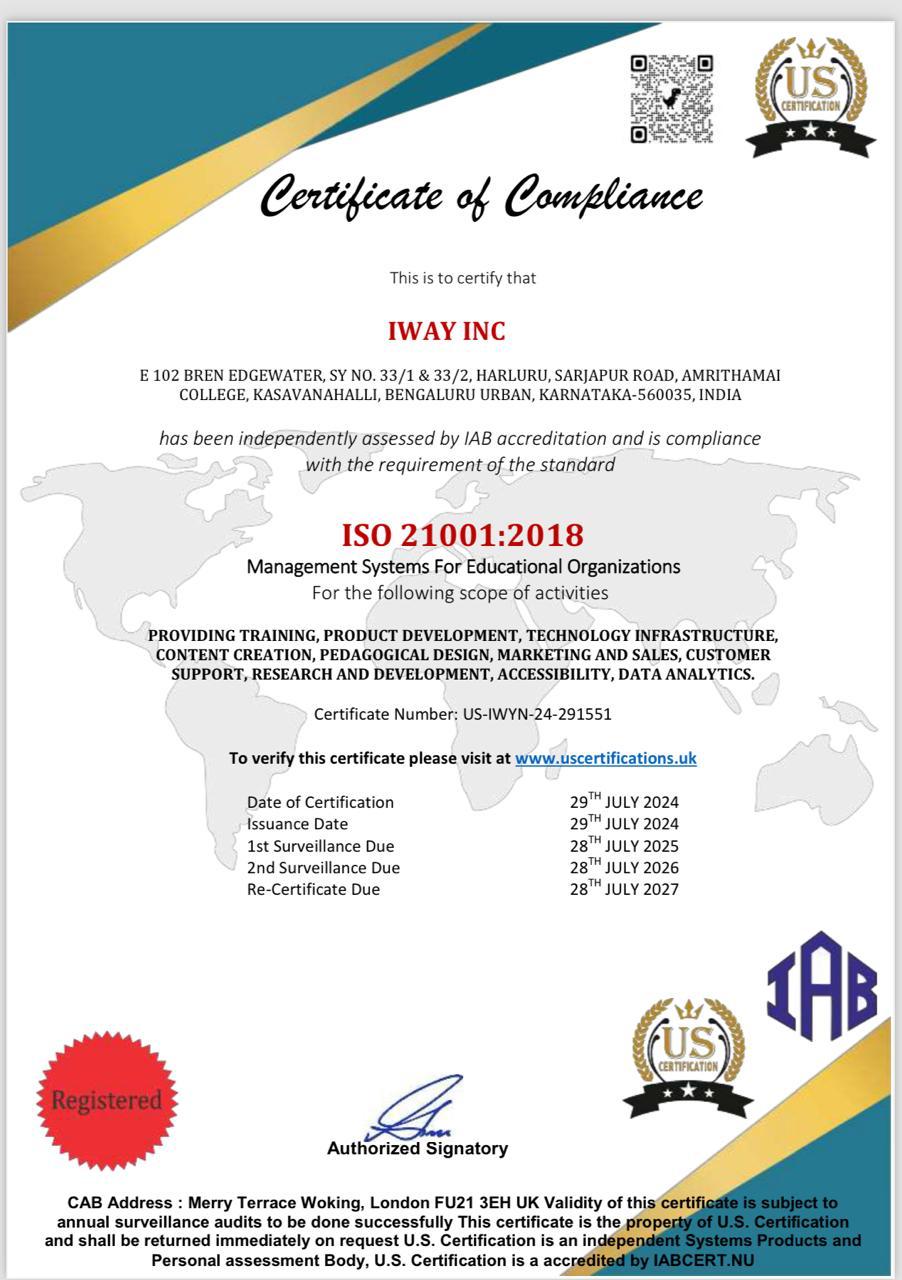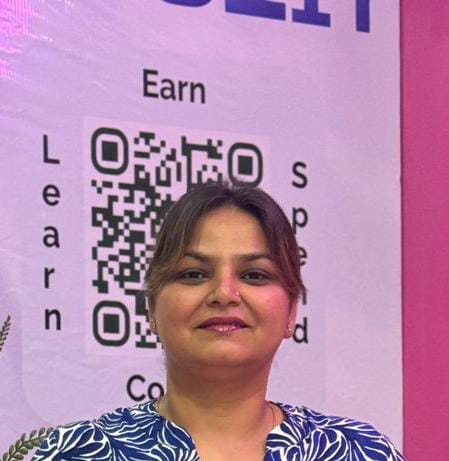Gigabyte - 9th December 2024
in GigabyteWhat you will learn?
Module 1: HTML Fundamentals
Module 2: CSS Essentials
Module 3: JavaScript Core Concepts
Module 4: jQuery Basics
Module 5: Database Management System (DBMS)
Module 6: Introduction to .NET Framework
Module 7: C# Programming
Module 8: Object-Oriented Programming (OOP)
Module 9: Exception Handling in C#
Module 10: Generics and Collections
Module 11: File Handling and Serialization
Module 12: Asynchronous Programming
Module 13: REST API Development
Module 14: Web Development with React.js
Module 15: Source Code Management with GIT
Module 16: Capstone Project
Module 17: Cloud Computing & DevOps
Module 18: AI Prompt Engineering
Interview Skills Development Program
Mock Interviews
Career Services
About this course
Launch your full-stack development career! Our meticulously designed courses equip college freshers and aspiring professionals with the skills they need to thrive in the industry. Master the fundamentals of front-end development (HTML, CSS, JavaScript, jQuery) and back-end development (Object-Oriented Programming, data structures, server-side programming, databases, API integration).
Go beyond theory with real-world projects using Azure DevOps and cloud technologies. This comprehensive program takes you from beginner to advanced, preparing you for a dynamic career as a versatile full-stack developer.
Duration: 150 hours
Bonus: The candidate will receive a course completion certificate that can be showcased on resumes and LinkedIn profiles, highlighting their achievement.
Suggested by top companies
Top companies suggest this course to their employees and staff.

Comments (0)
What is the internet?
How does the web work?
The role of HTML and CSS
Setting up a development environment (code editor, browser)
HTML Basics
Structure of an HTML document
Elements, attributes, and values
Text formatting (headings, paragraphs, emphasis)
Lists (ordered and unordered)
Links (anchors)
Images
Creating input fields (text, number, email, etc.)
Buttons (submit, reset)
Labels
Form validation
Introduction to CSS
Selectors (element, class, ID)
Properties and values
Styling text (font, color, size)
Styling elements (background, border, margin, padding)
Block, inline, and inline-block elements
Float and clear properties
CSS Grid
Advanced CSS Topics
Positioning (relative, absolute, fixed)
Units of measurement (pixels, percentages, ems, rems)
Color theory and color models
Media queries for responsive design
What is a database?
Define a database and its components (tables, records, fields)
Explain the role of a DBMS (Database Management System)
Introduction to SQL
SQL as a language for interacting with databases
Basic SQL syntax and structure
Common SQL commands (SELECT, FROM, WHERE, ORDER BY)
Data types in SQL
Numeric (INT, DECIMAL, FLOAT)
Character (CHAR, VARCHAR)
Date and Time (DATE, TIME, DATETIME)
Boolean (BIT)
Creating tables
Using the CREATE TABLE statement
Defining columns, data types, and constraints (PRIMARY KEY, FOREIGN KEY, NOT NULL)
Inserting data
Using the INSERT INTO statement
Handling NULL values
Updating data
Using the UPDATE statement
Updating multiple rows
Deleting data
Using the DELETE statement
Deleting rows based on conditions
Filtering data
Using the WHERE clause with comparison operators (=, <, >, <=, >=, !=)
Using logical operators (AND, OR, NOT)
Combining conditions
Sorting data
Using the ORDER BY clause to sort results
Ascending and descending order
Grouping data
Using the GROUP BY clause to group rows
Aggregate functions (COUNT, SUM, AVG, MIN, MAX)
Joins
Inner join, left join, right join, full outer join
Combining data from multiple tables
Subqueries
Nested queries within a SELECT, WHERE, or HAVING clause
Correlated subqueries
Indexes
Creating indexes to improve query performance
Types of indexes (clustered, non-clustered)
Performance tuning
Identifying performance bottlenecks
Query optimization techniques (explain plans, query rewriting)
Stored procedures
Creating and executing stored procedures
Passing parameters
Returning results
Functions
Creating and using functions
Scalar functions and table-valued functions
Transactions
Defining transactions
Committing and rolling back transactions
ACID properties
Atomicity, consistency, isolation, durability
Database design principles
Entity-relationship (ER) diagrams
Normalization (1NF, 2NF, 3NF)
Normalization techniques
Identifying functional dependencies
Eliminating anomalies
Database security
User accounts and permissions
Encryption
Auditing
Database backup
Creating backups
Restoring databases
Practice exercises
Applying SQL concepts to real-world scenarios
Troubleshooting common SQL errors
Question and answer Class
Addressing learners' questions and concerns
What is version control?
Why is it important?
What is Git?
What is GitHub?
Setting up Git and creating a GitHub account
Version control terminology:
Repository
Branch
Master
Stage
Commit
Clone
Push
Pull
Fetch
VS Code Integration
Staging and Committing Changes
Repository Management Commands
Branching and Merging
Viewing and Comparing Changes
Adding a Remote Repository
What is the .NET Framework?
What is ?
Why use ?
Installing Visual Studio
Creating a new Console App project
output
comments
Variables
Constants
Data types
Type casting
Operators:
Arithmetic operators
operators continued:
Assignment Operators
Comparison Operators
Logical Operators
Control structures:
if statement
if...else statement
if...else ladder
switch case
Loops:
while loop
do...while loop
for loop
break and continue statements
methods/functions:
Creating a method
Calling a method
Parameters and arguments
Default parameter values
Return values
Named arguments
Method overloading
What is OOP?
Classes and members
Constructors
Constructor parameters
Access modifiers
Encapsulation
Properties
Inheritance
Polymorphism
Abstraction
Interfaces
Exceptions: try...catch, throw
Generics: introduction, generic classes
Generic collections:
List
Dictionary
SortedList
Queue
Stack
Setting up the development environment
Creating a new ASP.NET Core Web API project
Understanding the project structure
Building a basic REST API endpoint
HTTP methods (GET, POST, PUT, DELETE)
JSON serialization and deserialization
Implementing CRUD operations (Create, Read, Update, Delete)
Handling HTTP status codes
Error handling and exception management
Data validation and input sanitization
Authentication and authorization (basic authentication, JWT)
Versioning REST APIs
What is JavaScript?
Why is it called JavaScript?
What can in-browser JavaScript do?
JavaScript and VS Code
Code structure
Variables: let, var, const
Data Types:
Number
String
Boolean
Null
Undefined
Objects
typeof operator
Operators:
Mathematical Operators & their precedence
Comparison Operators
Logical Operators
if statement
if...else statement (including ternary operator)
else if ladder
switch case
Functions:
Function Declaration
Local variables
Outer variables
Parameters
Default values
Returning a value
Naming a function
Objects: the basics
Objects: continued
Strings: properties and methods
Arrays: creation, access, manipulation
Array functions: map, filter, reduce, etc.
Classes
Constructors
Getters and setters
Inheritance
Querying and selecting elements
Traversing elements
Creating elements
Updating elements
Removing elements
What is React? Why use React?
React vs. other frameworks (Vue, Angular)
Setting up React using create-react-app
Overview of the folder structure
Running the first React app (npm start)
Introduction to JSX
What are React components? Functional vs. Class components
Creating a functional component
Understanding JSX and embedding expressions
Component properties (props)
Nesting and reusing components
What is state? Difference between state and props
Using the useState hook for functional components
Handling state updates
Conditional rendering based on state
Introduction to lifecycle methods (for awareness)
Handling events in React (onClick, onChange, etc.)
Passing arguments to event handlers
Handling form submission
Understanding synthetic events
Using conditional rendering (if-else, ternary operators)
Rendering lists using map
Using keys in lists
Dynamic list rendering and managing state
Introduction to React Router
Setting up routes
Navigation using Link and NavLink
Passing parameters to routes
Handling 404 pages
Inline styling
CSS stylesheets
CSS Modules
Styled-components (optional)
Best practices for styling React apps
Using fetch and axios for GET requests
Using useEffect for data fetching
Handling loading and error states
Displaying fetched data in components
Creating and submitting data using POST requests
Updating data with PUT requests
Deleting data with DELETE requests
Handling API responses and errors
What is Redux? Why use it?
Setting up Redux in a React app
Creating actions, reducers, and the Redux store
Connecting Redux to React components with useDispatch and useSelector
Introduction to Redux Thunk for async actions
Dispatching actions in asynchronous code
Handling API calls with Redux
Best practices for managing async actions
Authentication concepts (login, logout, user roles)
Handling user sessions using tokens (JWT)
Protecting routes using PrivateRoute components
Storing authentication state in Redux
Implementing role-based access (admin vs. user)
Using localStorage to persist user sessions
Logout functionality and session expiration
Handling authentication errors
Design and implement a user-friendly interface using modern web technologies
Build efficient database schemas using SQL or NoSQL databases.
Develop RESTful APIs for seamless frontend-backend communication.
Master version control and collaboration using Git.
What is Cloud Computing?
Types of Clouds
Cloud Computing Models – SaaS / PaaS / IaaS
Data Centres and Availability Zones
Overview of a Cloud Platform (Microsoft Azure)
Exploring Various Cloud Resources
AI and its Applications
Explore real-world AI use cases.
Machine Learning Concepts
Learn the fundamentals of machine learning.
Difference Between Machine Learning and AI
Understand the distinctions between AI and ML.
Generative AI, LLM, and Prompt Engineering
Delve into generative models and prompt creation.
Natural Language Processing
Study techniques for processing and understanding human language.
AI-Based Hands-on Project
Apply AI concepts in a practical project.
OOP Concepts
Classes & Objects
Encapsulation
Inheritance
Constructors
Recursive Functions
Searching Algorithms
Linear Search
Binary Search
What is a database?
Define a database and its components (tables, records, fields)
Explain the role of a DBMS (Database Management System)
Introduction to SQL
Data types in SQL
Creating tables
Inserting data
Updating data
Deleting data
Filtering data
Sorting data
Grouping data
Joins
Subqueries
Indexes
Performance tuning
Stored procedures
Function
Transactions
ACID properties
Database design principles
Entity-relationship (ER) diagrams
Normalization (1NF, 2NF, 3NF)
Normalization techniques
Identifying functional dependencies
Eliminating anomalies
Project Summary: Provide a brief overview of the project's goals, objectives, and the problem it aims to solve. Highlight key features and the project's impact or outcome.
Roles and Responsibilities: Clearly state your role in the project, focusing on specific tasks or modules you were responsible for. Emphasize contributions like coding, testing, or deployment.
Tech Stack Used: Mention the technologies, frameworks, and tools used in the project. Explain why you chose this tech stack and how it contributed to the project’s efficiency and scalability.
OOP Concepts Implementation: Describe how you applied Object-Oriented Programming principles (Encapsulation, Abstraction, Inheritance, Polymorphism) in your project, and how it improved code structure and reusability.
What is Cloud Computing?
Types of Clouds
Cloud Computing Models – SaaS / PaaS / IaaS
Data Centres and Availability Zones
Overview of a Cloud Platform (Microsoft Azure)
Exploring Various Cloud Resources
Learn how to handle real-world interview scenarios thru practice sessions with tech leads and hiring managers from top-tier organizations.
Meet & Greet: Learn how to effectively greet the interviewers and establish the first impression.
How to Present Yourself: Learn how to present yourself professionally, including mastering body language, attire, and clear communication to make a strong first impression.
We will train you to answer complex technical questions confidently, emphasizing problem-solving and practical knowledge application.
Behavioral Questions: Learn how to respond to behavioral questions using the STAR method, showcasing your interpersonal skills, teamwork, and ability to handle workplace challenges












